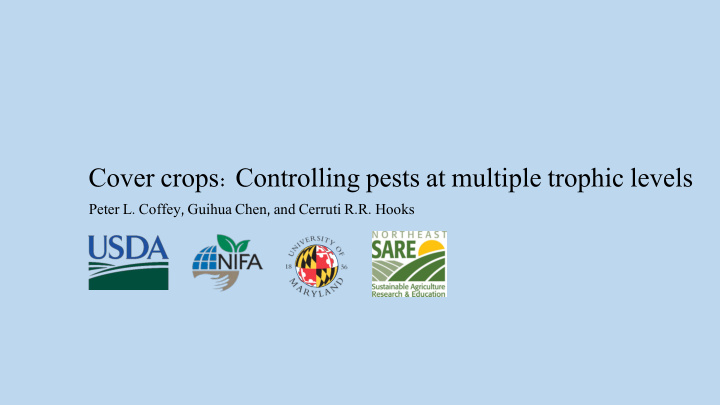



Cover crops: Controlling pests at multiple trophic levels Peter L. Coffey, Guihua Chen, and Cerruti R.R. Hooks
Clover-Rye Clover Fallow Clover-Rye Fallow Clover Clover Clover-Rye Fallow Clover Fallow Clover-Rye
80 Adult beetles arrived later in the clover-rye treatment, but persisted longer. 70 60 Mean Adults / Plot 50 40 30 20 10 0 17-Jun 25-Jun 2-Jul 10-Jul 17-Jul 24-Jul 31-Jul 7-Aug Clover Fallow Clover-Rye
90 There were more egg masses in the clover-rye treatment. 80 70 Mean Egg Masses / Plot 60 50 40 30 20 10 0 17-Jun 25-Jun 2-Jul 10-Jul 17-Jul 24-Jul 31-Jul 7-Aug Clover Fallow Clover-Rye
500 There were more larvae in the clover-rye treatment late in the season. 450 400 350 Mean Larvae / Plot 300 250 200 150 100 50 0 17-Jun 25-Jun 2-Jul 10-Jul 17-Jul 24-Jul 31-Jul 7-Aug Clover Fallow Clover-Rye
35 Adult and nymph numbers were not affected by cover crop treatment. 30 Mean Stink Bugs / Plot (n) 25 20 15 10 5 0 17-Jul 24-Jul 31-Jul 7-Aug Clover Fallow Mix
There were fewer spined soldier bug egg masses in the clover-rye treatment. 16 14 Mean Stink Bugs / Plot (n) 12 10 8 6 * 4 2 0 Clover Clover-Rye Fallow
25% The spined soldier bug eggs laid in the clover-rye treatment did not survive. Successfully Hatching Spined Soldier Bug 20% 15% Eggs 10% 5% * 0% Clover Fallow Mix
Parasitism rate was not measurably affected by treatment 50% Percent of Spined Soldier Bug Eggs Parasitized 40% 30% 20% 10% 0% Clover Fallow Clover-Rye
Identification of parasitoids reared from all egg masses will allow us to compare parasite populations
There was significantly more marketable fruit in the clover treatment 14000 * 12000 Mean Kg Marketable Eggplant / ha 10000 8000 6000 4000 2000 0 Clover Clover-Rye Fallow
• The clover-rye mix underperformed the clover alone, and had higher pest numbers. • Predators avoided ovipositing in the clover-rye mix, and failed to hatch when they did. • Ongoing research is investigating if the cover crop treatments may be altering the parasitoid population in the field.
Recommend
More recommend